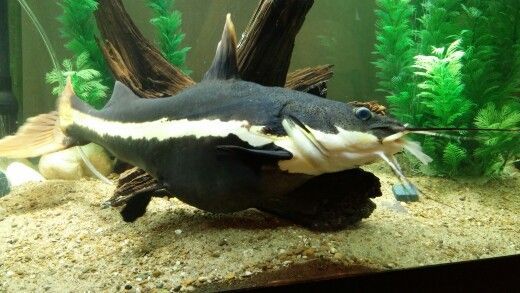
There are a lot of catfishes in the hobby, many of which grow to sizes that are not very manageable for most hobbyists. When the topic of jumbo catfishes comes up, it seems that most hobbyists think of the red-tailed cat, shovelnoses and other predatory catfish.
Predatory catfish are occasionally available at small sizes. In fact the tiger shovelnose is bred in commercial quantities in Asia and can be readily imported by wholesalers at small sizes. By the way, a few years ago there were quite a lot of catfish being marketed as a hybrid shovelnose cat. There have been no known hybrids of any of the shovelnose cats. The fish marketed as hybrid shovelnose cat was Hemisorubim platyrhynchus, which I’d rather have than a hybrid any day. I don’t know why the wholesalers and retailers couldn’t properly identify that one, but I think it has more to do with a lack of effort than a lack of information. All these fish readily take live foods and some can be trained to take pellet foods. I once raised an Ashara catfish (Perrunichthys perruno) from about 3 inches to 14 inches without ever feeding any live food at all.
There is an inherent problem with raising the large predatory catfish though. They can be a little skittish and before they have gotten too big for their aquarium, they tend to damage themselves when they panic and smash themselves into the side of the tank. I must have seen at least a hundred shovelnose cats in stores, probably customer trade-ins, which had damage to their snouts that looked like a result of a run in with the side of a tank. They have their snouts severely bent either up or down. It’s not an appealing sight. Due to the nature of this problem, you have to consider seriously if you’ve really got the tank space for one of these species before purchasing one.
Another catfish that has this problem is one that is not normally thought of as being a jumbo catfish, the iridescent shark or Pagasius cat, Pangasius sutchi. I have also seen some larger specimens of these in stores that show damage which is likely to have been caused by a run in with a too small tank. There are huge numbers of these being sold, but you don’t see very many big ones around. One can only conclude that they are mostly dying along the way and never reach anything close to adult size.
To get away from this problem, you might consider some species that get big, but are not predators. Two species from South America and one from Africa are occasionally available:
Pseudodoras niger, sometimes called turushuki or turushuqui, and Megalodoras irwini, sometimes called a mega Raphael cat, come from South America. They both have a temperament similar to a Raphael cat, but the turushuki has an adult size of about 3 feet, while the adult mega Raphael is about 2 feet long. The turushuki has a very prominent row of very sharp and dangerous looking scales on each side. The mega Raphael has similar scales which are not so prominent. Those experienced with Raphael cats will expect these two species to want to hide a lot. This is true for the mega Raphael but the turushuki is a little “friendlier” and may even come up to the front of the tank to be fed. Despite their size, neither species will molest their tankmates, even if they are relatively small. They are detritivores that spend their time scavenging the bottom. The turushuki will even take up mouthfuls of substrate and blow it out the gills to filter out any food particles that might be there. Though they are big enough to move a lot of gravel, they do not disturb it as much as Geophagus type cichlids will. Shipments of both of these species may be contaminated with cogeners (or even less related species) which may not be discernible at first sight, but on closer examination will be seen to be of a different pattern or body shape. These contaminants are probably of the same temperament as the identified species, but may not have as large an adult size. In fact, one of the contaminants of the turushuki may be Hassar species which will grow to about 8 inches.
The African species that is occasionally available is Auchenoglanis occidentalis, sometimes known as the giraffe nosed cat or just giraffe cat. The pattern is very reminiscent of a giraffe. This fish grows to a size of about 3 feet. It will also sift the bottom in search of food particles. Some writers have stated that they will eat smaller fish, but I have not experienced this. I recall having read somewhere quite a while back that there was a public aquarium in Europe that had a specimen that had been with them for 26 years and still going. There is a similar species that may come in as contaminants, Auchenoglanis biscuttatus.
If you want to try one of the jumbo catfishes, you should think about having a tank larger than the 6 foot long tanks that are commonly offered as being the larger production glass aquariums. For a fish approaching 3 feet long, those tanks just aren’t big enough for the fish to turn around in.
Leave a Reply